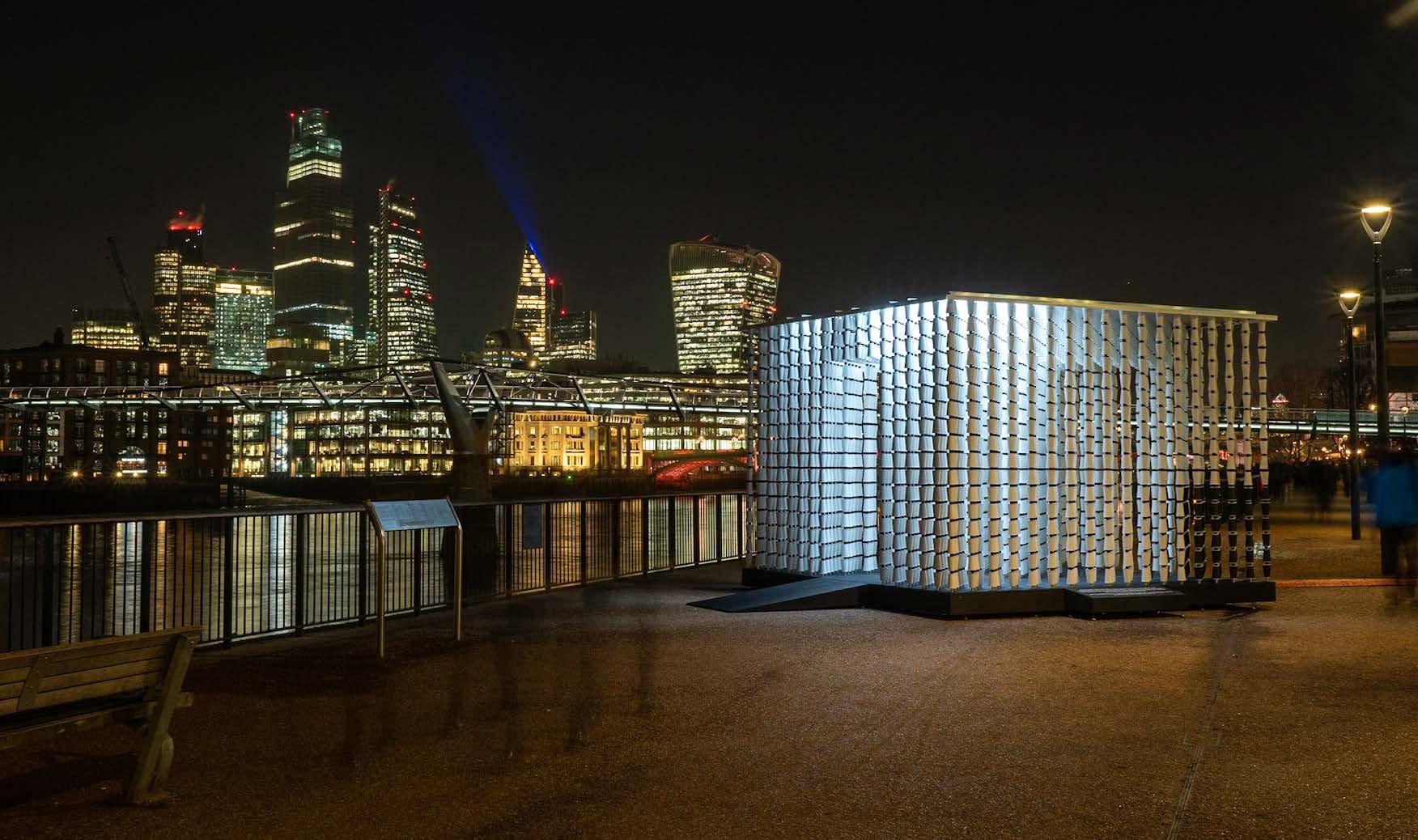

The Cup Fund Impact

Grosvenor
Network
University
Westmorland
Oxford
Brixton
British

SUMMARY
In 2019, Hubbub and Starbucks launched the Cup Fund, which granted between £50,000 and £100,000 to 13 ambitious coffee cup recycling projects across the UK. The UK has the recycling facilities to recycle every cup used, but we do not currently have the infrastructure of recycling bins to collect them from the public.
The Cup Fund aimed to kickstart cup recycling by introducing new cup recycling bins in highfootfall locations, creating new partnerships, and delivering high-quality behaviour-change communications to inform the public that cups can be recycled and how they can do so. Hubbub provided ongoing support to successful applicants based on our expertise and experience in delivering successful cup recycling campaigns, such as Square Mile Challenge and In the Loop.

The fund was made possible by Starbucks’ pioneering 5p cup charge which is applied when a customer buys a drink in a single-use cup. Introduced voluntarily in 2018, the funds support waste reduction and wider sustainability efforts, with the goal of helping to create stronger, greener communities. Successful projects were selected by an independent grant panel consisting of Hubbub, Starbucks, Chartered Institute of Waste Management (CIWM) and LARAC, who represent local authorities on recycling and waste.
We funded a broad range of organisations and types of projects: local authorities, waste contractors, Business Improvement Districts, universities, rail operators, motorway service stations and more. Grants were used to fund recycling infrastructure, collection costs, communications materials and marketing support, and staff time to create, deliver and evaluate the campaign.
Summary
Over 4.4 million cups have been recycled through funded projects so far, reducing carbon emissions by 48 tonnes. Although significant, this figure is lower than originally anticipated because of the impact of the COVID-19 lockdowns, the first of which happened as the first projects were launching. This presented several significant challenges to the funded projects: there were far fewer coffee cups to collect during lockdowns; streamlining and re-prioritisation of waste team operations; ongoing staff shortages were common; changes in key project personnel.
Despite these challenges, many projects demonstrated admirable resilience and imagination to adapt to the unprecedented situation and deliver high-quality results.
With mandatory in-store cup recycling due to be introduced in 2024 in the UK, cup recycling will become more important than ever in the UK.

This report contains important lessons which can help other cup recycling projects succeed.
While it’s important to provide adequate recycling systems for customers, Hubbub and Starbucks are also using the funds from the 5p cup charge to focus closely on reuse to reduce the number of single-use cups used in the first place. Projects such as The Bring It Back Fund are providing valuable lessons on how to implement effective reuse systems for food and drink packaging.
JOURNEY OF A COFFEE CUP
1. Source
The timber for most coffee cups comes from sustainably managed forests.
The wood pulp is turned into cup board and combined with a 5% polyethylene liningand bonded together at high temperatures. This mix of materials means the cups cannot be recycled with other paper recycling.
Only 4% of coffee cups are currently recycled. That’s where the Cup Fund comes in.
4. Coffee cups can be recycled
Recyclers separate the paper and plastic and break the cup down into pulp to make into brand-new paper products. While disposable coffee cups are recyclable in specialist facilities, they are not currently widely recyclable in most local authority recycling centres. That means they need to be disposed of and collected separately from all other waste to be recycled. There are currently only three recycling facilities in the UK which have the ability to recycle coffee cups; Ace UK, DS Smith and James Cropper.
WHAT WE SET OUT TO DO
Collection costs
13 projects funded to kickstart coffee cup recycling. These funds could be used towards...
Recycling infastructure
Communications materials and PR/marketing support
Staff time to create, deliver and evaluate the campaign

WHAT WE ACHIEVED
*Calculated according to project final reports ** Tonnage calculated according to 11g cup average weight throughout the report
1,484
top tips for collecting coffee cups:
Keep a lid on contamination: this is the main reason why coffee cup recycling can fail, so do all you can to reduce it (read on the find out how...)
Inside or out: on-street bins can collect high volumes, but contamination is often high. Managed locations will generally see less volume, but better quality. Depending on your project aims and location, a combination of bins inside and outside is best.
Bins need buddies: to minimise contamination, always ensure cup bins are placed alongside general waste bins and mixed recycling bins to create obvious distinction.
Clear communications: strive for simple and consistent messaging. Use bold designs and colours to stand out from the crowd, and consider how else you can promote cup recycling, e.g. targeted social media. Hubbub can support with template communications assets.
Start small: some locations will work better than others depending on the type of footfall, so start small and be prepared to adapt.
Compostable confusion: compostable cups can’t be recycled so be careful of positioning cup recycling bins in the proximity of cafes which serve compostable cups, and consider how messaging can help.
For more tips, check out our guide
How to start cup reycling
Binspirational design: from cup-shaped bins to tube bins, there are lots of options and no perfect solution, so try to find the best combination for your setting.
Build familiarity: the longer the bins are, there, the more likely they are to work, especially in locations with repeat footfall such as regular commuters.
Training is key: ensure that those emptying and maintaining the bins understand them and are bought into the process.
Partner and collaborate: for example, with local businesses, universities, hospitals and cafes, who can all expand the reach of your initiative.


Better Bankside BID & Team London Bridge (London)
Bristol Waste Company (Bristol)
British Land / Giltbrook Retail Park (Nottingham)
Brixton BID (London)
Bywaters (London)
Camden Climate Change Alliance (London)
DS Smith (UK-wide)
Forge Recycling (York)
Grosvenor Britain & Ireland (London)
Network Rail (UK-wide)
Oxford Direct Services (Oxford)
University of Northampton (Northampton)
Westmorland Ltd. (Cumbria & Gloucester)

Better Bankside BID
& Team London Bridge (London)
Team London Bridge and Better Bankside introduced a cup recycling scheme across London’s South Bank, which has some of the highest footfall in London and includes landmark sites such as Tate Modern and Borough Market
They introduced on-street bins and collections from cafes and offices, as well as a range of engaging communications.
Key learnings
Scale of project:
Still running as of Dec. 2022

• Bins were brightly coloured and placed next to general waste bins to avoid contamination.
• Contamination reduced over time from 98% to 30% as people became familiar with the bins and better understood what they are for.
• Keeping the public bins in good condition also ensures they are properly used and respected.

The Cup Cube Installation
To celebrate the introduction of coffee cup recycling on the Southbank and the four other London projects, Better Bankside, Team London Bridge and Hubbub launched the Cup Cube on the riverwalk close the the Tate Modern at the start of 2022.
London’s Mule Studio created the immersive 5x5 metre cube using 5,555 coffee cups (the amount we get through every minute in the UK). At the end, Blast Studio transformed all the cups into a biomaterial using mycellium to 3D print furniture, artefacts and architecture.




Target material in bins:
57%
Cups recycled so far: 808,000
Tonnes of cups recycled: 8.9
No. of bins: 74
Scale of project: City - centre wide
Bristol Waste Company (Bristol)
A partnership between Bristol Waste Company, Bristol City Council and local businesses introduced cup recycling bins next to general waste bins along key commuter routes throughout central Bristol.
They also worked with managed spaces to host cup recycling bins - for example, offices, cafes, shopping centres and hospitals.
They named the campaign “For Cup’s Sake” and teamed up with One Tree Per Child, pledging to plant a tree for every 10,000 cups recycled.
• While messaging on bin was eye catching, it wasn’t easy to view at night, leading to contamination. Glow in the dark messaging would help.
• Chalk stencils around the base of bins were used to capture attention and break automatic behaviours, which increased cups collected, but only led to a small reduction in contamination.
Still running as of Dec. 2022
Key learnings
• Managed spaces provided a much cleaner stream of cups than the on-street cup bins. Coffee shops were also effective at hosting recycling bins.
• The lack of other on-the-go recycling bins for other materials meant that the cup bins were often used for other recyclable materials.



Target material in bins:
TBC
Cups recycled so far:
300,000
Tonnes of cups recycled: 3.3
No. of bins:
• 22 coffee cup shaped bins
• 2 Reverse vending machines
Scale of project:
2 universities, 1 office/retail site
Coffee cup recycling was set up across three universities: the University of Westminster, Queen Mary University of London, and London School of Economics (LSE).
During COVID-19, the universities closed for a long period of time and collections were nonexistent. Post-pandemic, Bywaters observed a big behaviour shift in the number of employees going into the city.
Having stopped working with one university, they decided to join up with commercial office and retail space, Broadgate - a large, 32-acre office and retail estate in the City of London.
Key learnings
• Due to lower footfall in office areas, bins were cleaner and less contaminated than at universities - and contamination could be controlled more easily.
Still running as of Dec. 2022
• Reverse vending machines were designed to be eye-catching and stand out at the universities. However, they were unreliable and had many breakdowns.
• Additional signage was required across the sites to reduce contamination levels.
• Additional staff were required for collections and sorting the cups, especially removing the compostable cups.
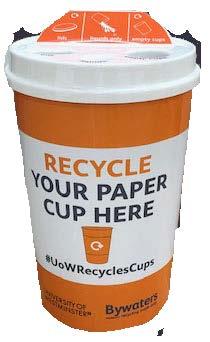

Bywaters (London)
Reverse vending machine
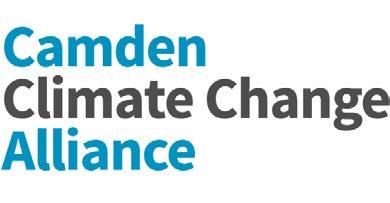
Target material in bins:
n/a
Cups recycled so far:
107,000
Tonnes of cups recycled: 1.2
No. of bins:
• 6 bins
• Nexus 100 Cup Recycling Station
Scale of project:
Borough - wide
Camden Climate Change Alliance (London)
A project between Camden Climate Change Alliance and Veolia which collected cups via on-street using road sweeping operatives, and through collection bins placed in offices and cafes across the Borough.
The project supported Camden Council’s 2025 vision of being a “clean, vibrant and sustainable” place and the ambition of recycling more of the borough’s waste.
Covid-19 Pandemic affected the promotion of the course and the initial sign up boost from the first event. Both services were halted in the first lockdown. The service was not re-opened for businesses until late 2021/ early 2022 – which affected the number of potential businesses that could have signed up. In addition, during the pandemic with cafes and businesses shut, the demand for coffee cups also fell. This resulted in the service being adapted and targeting different type of businesses (hospitals, colleges and markets).
• Bins in smaller offices did not produce high volumes of cups.
• Buy-in from businesses was difficult. Challenges included: reduced volumes from hybrid working patterns and venues that used compostable cups which cannot be recycled.
• Requiring businesses to box up their coffee cup for collections presented an additional barrier to use.
• Persuading cafes to sign up to the service was difficult, because takeaway customers take their cups off site.
Still running as of Dec. 2022
Key learnings
• The street collection process (collecting cups from on-street bins and pavement) has been a success will continue going forward.


Target material in bins: n/a
Cups recycled so far: 840,000
Tonnes of cups recycled: 9.2
No. of bins: 1,200 drop boxes
Scale of project: UK - wide
As of December 2022, DS Smith no longer offer the Drop Box as a collection service.
DS Smith (UK - wide)
DS Smith worked in partnership with Associated Vending Services (AVS) to collect cups from vending machines in public, private and municipal locations (including offices) throughout the UK.
They created cardboard Drop Boxes made of 100% recycled materials that can hold up to 700 used cups. Boxes were placed next to vending machines and, once full, were collected by couriers and sent to DS Smith who are one of the UK facilities able to recycle cups.
Sales of drop boxes were badly hit by lockdowns and the shift to home working and the business decided to re-prioritise once the funding had ended.
Key learnings
• There appears to be limited appetite for a Drop Box as a solution to cup recycling.
• Whilst the box was large enough to serve an office-type space, it could not be used for large public events.
• Anecdotally they saw minimal contamination in the coffee cups received, due to the design of the box requiring cups to be stacked upside down.
• Some customers were uncertain how to return their box for recycling, despite instructions on the box. For any future versions, this should be clearer for the customer.


Target material in bins: 94%
Cups recycled so far: 800,000
Tonnes of cups recycled: 8.8
No. of bins: 20
Scale of project: City - wide

Forge Recycling (York)
Forge Recycling partnered with York BID, LNER and two universities to introduce cup recycling across the city, building on their previous work introducing cup recycling to Leeds.
Cups were stored in order to consolidate collections and Forge Recycling pre-sorted the waste at each venue hosting the cup bins before being sent to recycling, which significantly reduced contamination levels.
Key learnings
• Having learned in Leeds that on-street bins are prone to contamination, Forge didn’t use any on-street bins in York and contamination was reduced as a result.

Grosvenor Britain & Ireland
(London)
The ‘Recycle UP’ project introduced specially designed bins in office buildings and high footfall public areas in Mayfair and Belgravia in central London. They were all coffee cup-shaped (Leafield Envirocup Grande).
Key learnings
• Experienced high contamination levels due to issues with the bin design and communications. Switching to transparent tube bins, from the original bin designs proved more successful.
Still running as of Dec. 2022
• Collaboration and partnerships were key to success, for example with local businesses and universities.
• The most effective bins were tube bins in the station, with cup bins working best in managed spaces.
• Train stations have very specific bin requirements due to safety concerns, so Forge worked closely with LNER to find the right solution.
Scale of project: 6 locations in Mayfair and Belgravia

Still running as of Dec. 2022
• Future plans include adding clear signage on and around the bins and communicating the project on their consumer-facing channels and to their tenants.

Network
Rail (UK - wide)
Target material in bins: n/a
No. of cups recycled: (Sep 2020 - Sep 2021)
227,100
Tonnes of cups recycled: 2.5
No. of bins: 79
Scale of project: UK - wide
Network Rail introduced cup recycling at 19 mainline stations across the UK, in partnership with Mitie and Interserve (who were subsequently acquired by Mitie). They installed specially designed bright orange tubes bins at all managed stations, following lengthy COVID-19 enforced delays.
Due to COVID-19, footfall at stations was extremely low in 2020, and this had an impact on the number of cups collected.
Key learnings
• The tube bins that Network Rail had made to bespoke DfT standards have been problematic:
• The receptacles fill up quickly which requires more frequent emptying of the bins, pulling resources away from other equally important duties.
Still running as of Dec. 2022
• Emptying the receptacles is more onerous than a standard bin.
• Network Rail used the colour orange to make the tube bins clearly visible within their stations, in line with WRAP’s suggested colour for carton recycling.
• Contamination has been kept to a minimum at stations, due to monitoring from cleaning operatives.

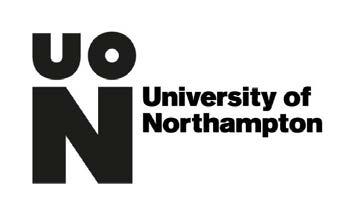
University of Northampton (Northampton)
The project spanned the University, The Royal & Derngate Theatre, The Grosvenor Shopping Centre and Northampton General Hospital.
The majority of the bins used were branded cup-shaped bins, with the train station using three free-standing tube bins.
The pandemic led to the closure or reprioritisation of many of the locations, which significantly held back the project as it proved difficult to re-engage partners whose priorities had shifted.
Key learnings

Target material in bins: Awaiting no.
Cups recycled so far:
Westmorland Ltd. (Cumbria and Gloucestershire)
The Westmorland Family business launched a coffee cup recycling scheme with bins at its motorway service areas in Tebay and Gloucester, which have 10 million customers pass through each year.
The aim is to provide people who are on the road a lot with road side services that offer cup recycling.
Tonnes of cups recycled: 3.3
No. of bins: 11
COVID-19 set the project back and saw them close the business except for a skeleton team. However, by June 2021 all bins were in place and they now have plans to roll out the scheme further.
Key learnings

Still running as of Dec. 2022
• The cup-shaped bin worked well but only in a highly managed area, such as within cafés that are closely managed by staff who can remove the small amount of contaminants.
• The best performing bins were those positioned where there was returning footfall and people were able to get into the habit of using the bins.
• Face-to-face education at events such as Go Green week and Freshers Week proved to be an effective way to communicate the project.
Scale of project: Tebay and Gloucester motorway service areas

Still running as of Dec. 2022
• Westmorland found it effective to use tube bins with a large backboard, allowing lots of space for clear instructions to encourage correct use of bin.
• To avoid confusion, they ensured that the openings of each of the three tubes was specific to the item that needed to be placed inside of it, e.g. cup, lid, liquid.
• The cup recycling bins are visible as soon as customers enter the car park, inside the buildings and in all key locations.
• Contamination wasn’t an issue. They had minimal issues with lids being left on cups - and most customers seperated out. They ended up removing the film they initially put on the tubes so customers could clearly see what was to go in each.

Target material in bins: Not recorded
Cups recycled so far: Project discontinued
Tonnes of cups recycled: N/a
No. of bins: 10
Scale of project: Oxford City Centre
The scheme has been discontinued.
Oxford Direct Services (Oxford)
Oxford Direct Services (ODS) planned to install 40 dedicated on-street coffee cup recycling bins in high footfall areas across city centre, Summertown high street and Headington high street.
They called their campaign #ACupOfInspiration and together with the City Council, they launched a competition for Oxfordshire residents to design artwork for the bins that would encourage people to think about the environment and recycle their cups.
Initially due to the pandemic and more recently due to chronic staffing issues, ODS were not able to properly get the project off the ground. 10 Bins were wrapped and rolled out across the city centre and only a minimal number of cups have been recycled to date. The project has now been discontinued.


Project on hold
Brixton BID (London)
The Brixton BID project aimed create a cup recycling network across independent coffee shops in Brixton.
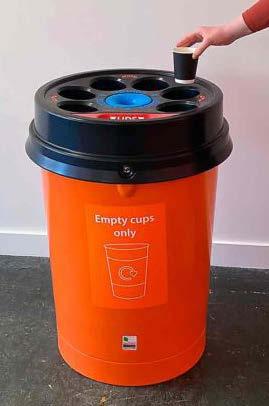
Due to lockdowns, priorities dramatically shifted for the independent stores who had initially signed up and the project had to be halted. Brixton BID attempted several other variations of the project but have been unable to get any of them off the ground.
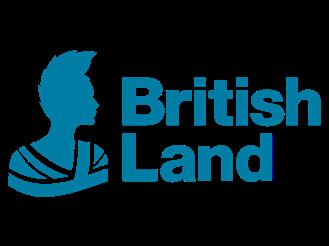
Target material in bins:
British
Land / Giltbrook Retail Park (Nottingham)
Cups recycled so far:
Tonnes of cups recycled: 0.7
No. of bins:
10 external bins
7 internal bins
Scale of project: Contained retail park
The scheme has been discontinued.
Giltbrook Retail Park launched 10 coffee cup recycling bins across its retail and industrial park in Nottingham, along with an additional 12 mixed waste bins to enable visitors to separate their waste. All of the cup bins were orange, in keeping with Hubbub’s suggested colour scheme.
Giltbrook Retail Park remained open during the lockdowns, but cup collections were halted in early 2021 due to numerous changes in personnel and a change in waste contractor.
Key learnings
• A soft launch to test bin placement provided useful insight data to inform the placement of the cup bins to the greatest catchment areas, leading to an increase in cup collection.
• Promotional decals and posters placed across the site helped to raise awareness of the scheme
• The project team found that asking customers to recycle the whole cup without separating the lid improved recycling rates, although this did require additional sorting from the waste teams.

APPENDICES
Good Communications
Clear messaging: People spend less than 2 seconds at a bin, so communicating quicky and clearly is essential for increasing collection of coffee cups and reducing contamination. It is crucial to think about how users interact with bins, and to ensure messaging can be viewed when at the bin (e.g., from above) as well as from a distance.
Be a show-off: Bins that stand out from the crowd proved to be effective and are the most potent communications tool.
Education is key: If the general public is not made aware this will not work. Social media, press and signage are good ways to increase awareness, aside from the bins themselves.
Provide consistent communications: Use the same language, colours, design across all platforms – to encourage consistent recycling behaviour.

Bin Design
Coffee cup shaped bin: Advantages are that it is clear it is for coffee cups and stands out in public realm areas, as well as having a large capacity to reduce need for very frequent maintenance. However they are opaque and large, leading to higher contamination.
Tube bins: Can help to prevent contamination but in practice can easily become blocked and require more frequent emptying, cleaning and maintenance. Best installed indoors for regular checking. Consider a three bin / tube upright approach with a large backboard to give customers plenty of space to use the bins and understand how they work. Make sure the openings of each tube are specific to the ‘item’ – the size and shape - that needs to be placed inside of it.
Prevent theft: Bins are sometimes stolen, however they can be easily fastened and screwed down so they can’t be moved or cause any damage.
Drop boxes: Drop boxes for cups can hold up to 700 cups and are made of cardboard. Once full, they are collected by a courier and sent directly to the recycling plant. They showed some potential as a tabletop solution for smaller volumes linked to vending machine services. However, customers were unsure of how to return their box despite instructions on the box, and DS Smith have since discontinued this service.


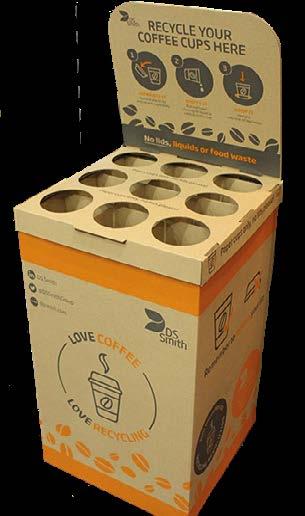
Preventing Contamination
The challenge with coffee cups is keeping them separate from other recycling so they can be collected and processed on their own. We want bins full of coffee cups and nothing else.
Bins need buddies: As with recycling bins, coffee cup recycling bins should be strategically positioned next to another bin to avoid contamination, ideally a general waste and mixed recycling bin. Bins that are inside managed spaces tend to be a lot less contaminated than bins on streets. However, most takeaway coffees are consumed on-the-go and therefore thrown away in on-street bins, so a combination of bins inside and outside is best. Bristol Waste Company found the public used cup bins for ‘general recycling’ as there was no nearby mixed recycling bin.
Allow time to embed: Projects found that the longer the bins were in place, the less contamination there was. For example, Better Bankside found people got used to the bins over time and better understood what they are for.
Consider resource just for sorting: Lids and straws are commonly found in coffee cup recycling bins. Some of the projects found it beneficial to deal with it at the collection side, not the customer side, with the team separating the contamination from the cups.
Start with a test bin: Many projects found it useful to trial a small number of cup bin locations and messaging first and use the findings to determine the full deployment of bins. For example Westmorland found that contamination was high on their initial test bin, which led to them changing the bin positioning, aperture and messaging which made a huge difference and contamination is now very low.
Train internal staff: This is a must. Offer training to housekeeping teams to ensure everyone is aware of the importance of keeping the coffee cups separate. Use posters and back-of house signs for reminders of what is contamination and what isn’t. When staff are fully aware they can help reduce contamination.
Can you see the contamination? Being able to see what’s in the bin helps prevent contamination by the user. Transparent bins can help with this, and using clear plastic sacks also allows for maintenance staff to see the level of contamination before putting the bags in the collection bins
Be aware of compostable cups: Compostable and biodegradable cups cannot be recycled and are an unwanted complication for paper cup recycling. Understandably, the public generally don’t understand the difference and therefore place compostable cups in cup recycling bins thinking they are doing the right thing. Messaging on the bins themselves can help here, as well as avoiding placing cup recycling bins in areas where a lot of compostable cups are sold. Engage local businesses and cafes to educate them on what can be recycled. Consider extra staff for separating the paper from compostable cups.
